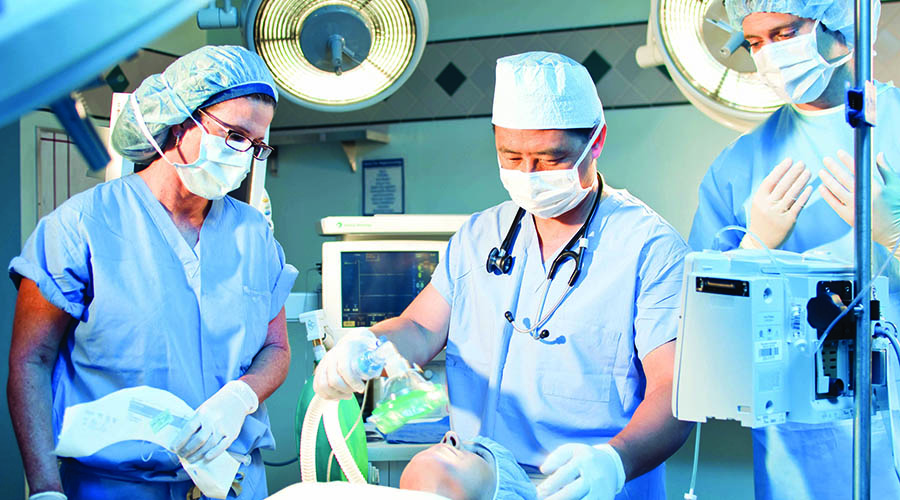By Sonya Pease, MD, Chief Medical Officer, Anesthesiology
Does anyone remember the Ploss Valve? It was this nifty little piece of plastic that created a switch valve that allowed us to simultaneously monitor the patients’ blood pressure, pulse and respirations through our earpiece. Long before the days of automated blood pressure cuffs and the invention of the pulse oximeter, when setting up your room, this was one of the first things you looked for and checked that it was not cracked or leaking air. This tool was low tech but effective in reducing the manual work of connecting to each vital sign monitor independently.
Today we live in an environment where the safety and quality of anesthesiology care has improved at least 10-fold throughout the past 20 years. Unfortunately, anesthesiology still does contribute to major and avoidable complications and deaths and is still not completely safe for ASA I or II status patients. So what will it take to achieve zero-defects in anesthesiology-related harm? What new medications, devices, new technology and clinical decision support tools are on the horizon?
10 Predictions:
- Pharmacogenetic testing will become standard clinical workflow to the point that pharmacotherapy will be personalized to an individual patient based on their predicted response to that therapy. Improvements in medication management based on a patient’s genotype will drive down opioid usage and further advance enhanced recovery care pathways.
- Non-Invasive Cardiac Output measurement will become just another routine vital sign we incorporate into pre-operative testing, perioperative monitoring and PACU care. The ability to non-invasively assess advanced hemodynamics continuously at the bedside will take a lot of guesswork out of perioperative management.
- Anesthesia Information Management Systems (AIMS) with intraoperative monitoring device connectivity will provide powerful decision support tools with real-time clinical guidance utilizing machine learning algorithms to predict things like hypotension long before it occurs clinically.
- Artificial Intelligence will transform patient care with advanced Early Warning Systems (EWS) that utilize wireless surveillance to leverage algorithms for pattern recognition, allowing computers to detect slight variations in data with human-applied clinical rules (algorithms) that recognize patient deterioration and automatically activate interventions like rapid response teams, making “found dead in bed” a never event.
- Cardiovascular imaging with artificial intelligence software will automate calculation of left ventricular ejection fraction, making this a new standard vital sign for procedures using intraoperative cardiac echography.
- Pre-operative testing will be performed in virtual clinics by a “cognitive assistant” type platform that will complete repetitive tasks and engage patients through interactive patient portals to establish optimization pathways prior to procedural care. With analytical and reasoning capabilities and a wide range of clinical knowledge, this automated routine work will support clinical decision-making and free clinicians to focus more on direct patient communication and complex care decisions.
- Patients will have 24/7 access to virtual nurse avatars who will help manage home medications and provide health assistance and coaching on healthier choices that support lifestyle changes.
- Wearable home devices will be able to detect an asthma attack before it happens and new biosensor devices with electrocardiogram (ECG) electrodes and triple-axis accelerometers will track heart rate, rhythm, breathing, temperature, steps and even detect body position in case a person has fallen. We will no longer need to ask patients how active they are or if they have had any falls or been compliant with pre-habilitation exercises because these devices will be able to share this information to improve shared decision-making with our patients.
- Ingestible sensors and drug-device combination products will be able to monitor medication effectiveness and offer the ability to objectively track patient compliance. Imagine better-supporting families who are caring for family members with dementia or serious mental illness or even confirming the absence of illegal drugs to improve patient care and outcomes.
- A new novel anesthetic agent will be available that combines the sedative-hypnotic drug properties of current medications with a rapidly titratable intravenous delivery system with a high therapeutic index and minimal side effects. This will go beyond small modifications of current medications like a proposed remimazolam and move us into a new generation of anesthetics yet to be discovered. I think we should call this new anesthetic “Raplon” because I always liked this name back when we briefly used rapacuronium back in the 1990’s. It would be a great opportunity for us to go back to the future to at least reutilize this cool anesthetic agent name.
The next 10 years will be challenging, no doubt, as we redesign healthcare delivery to meet the demands of new payment methodologies while pursuing continued innovation that personalizes patient-specific care, improves vigilance and patient safety through machine learning, virtual assistants and early warning surveillance systems. In this next decade, I am confident we will get closer to our goal of “zero harm.”
Thank you all for everything you do to take great care of our patients and our communities every day. To learn how TeamHealth is transforming anesthesiology patient care contact call 800.818.1498 or email us at business_development@teamhealth.com.
